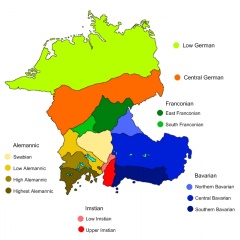Imstian Dialects
The Imstian Dialects build, together with Bavarian, Alemannic, South and East Franconian, the Upper German dialect group. The two Imstian main dialects are spoken in Germany, Austria and Italy by approximately 250.000 people. They do not have any official status in any state nor are they written officially.
Name
The linguistic term Imstian (German Imstlerisch) derives from the small city of Imst and the surrounding district with the same name, which is the region with the most Imstian speakers in the Imstian Sprachraum after Garmisch-Partenkirchen. The speakers themselves do not call their dialects so, in fact the term Schwäbisch is used in the north west, Alemannisch in the west and Bairisch in the east, so always according to the surrounding dialects (as many south Franconian speakers call themselves "Swabians" although they actually don't speak an Allemannic language).
Current Situation
Due to the widely not existing notice of a common language, the number of Imstian speakers decreases more and more. Especially in Austria, in the district Innsbruck-Land, speakers intend more and more to speak a South Bavarian idiom. The city of Telfs, for example, which is located in traditional Imstian Sprachraum, is now Bavarian-speaking due to massive immigration of workers from eastern Tyrol comming there to work in the still growing tourism branch.
Characteristics
As a High German dialect group, Imstian was affected by the High German Consonant Shift:
| High German | haben | halb | Schlafen | Schwein | es | essen | machen | Apfel | Herz |
| Upper Imstian | choo | choub | schloifo | Schwii | is | esso | mocho | Opfo | Cherz |
| English | Have | half | sleep | Swine | it | eat | make | apple | heart |
In distinction to Standart High German, it shares lots of features though with the surrounding dialects, especially that, as for nouns, the genitive and accusative cases are no longer productive as well as the disappearance of the synthetic preterite, which was replaced by the periphrasticly-built perfect:
| Disappearance of the preterite form | Building of the pluperfect form | Genitive construction | Accusative construction | Conjunctive construction in indirect speech | |
|---|---|---|---|---|---|
| High German | Ich gab es der Frau. | Ich hatte es gekauft. | Das Haus des Freundes ist schön. | Ich sehe den Löwen an. | Sie sagen, du seiest blöd. |
| (southern) South Franconian | E håb s dr Fråå gewə. | E håbs khååft khet. | əm fraend sae hous əsch schee. | E gug də Leef åå. | Di såågəd, do däädsch bleed sae. |
| Upper Imstian | I choi's iro froowo gebo. | I choi's krrooft krroit. | Imo fruuti siis chuus isch schoo. | I luo dir lef. | Di sogit, do toitisch tuufor soo. |
| English | I gave it to the woman. | I had bought it. | The friend's house is nice. | I am watching the lion. | They say you were dumb. |
Nevertheless Imstian has many differences that distinguish it from the other Upper German Dialects:
| Common plural form for verbs | Old High German ending -mês for 1st Person Plural remaining | Productive case endings | |
|---|---|---|---|
| Swabian | mr hend, ər hend, di hend YES |
mr send NO |
dr Leef, əm Leef NO |
| Upper Imstian | mir chois, ir choi, di choi NO |
mir biros (-os < -umês) YES |
dir Lef, imo Lefi YES |
| Central Bavarian | mia håm/håmma, eß håbts, se håm(t) NO |
mia sàn/hàn NO |
da Lef, am Lefn YES |
| Standart German | wir haben, ihr habt, sie haben NO |
wir sind NO |
der Löwe, dem Löwen YES |
| English | we have, you have, they have | we are | the lion, to the lion |
